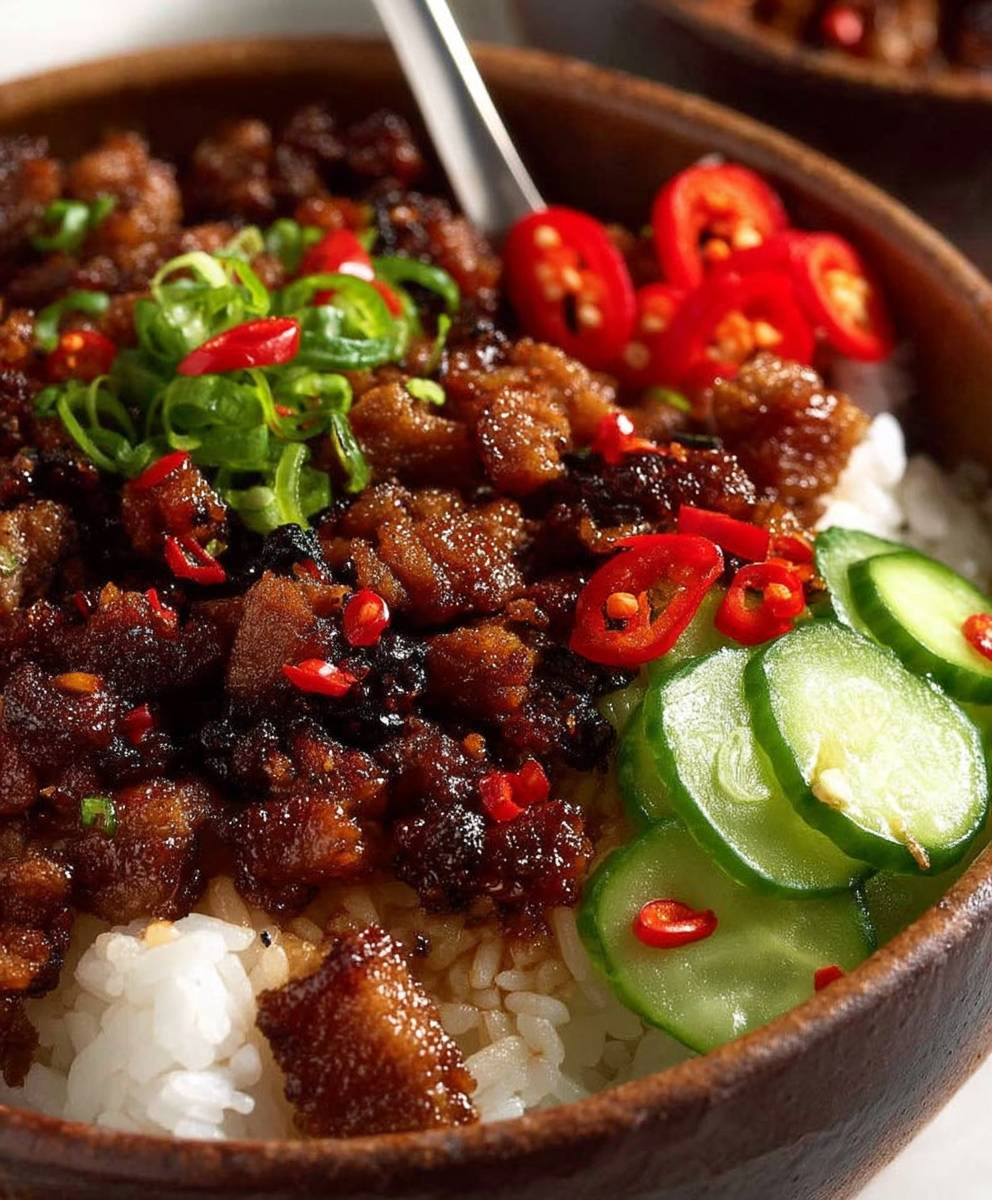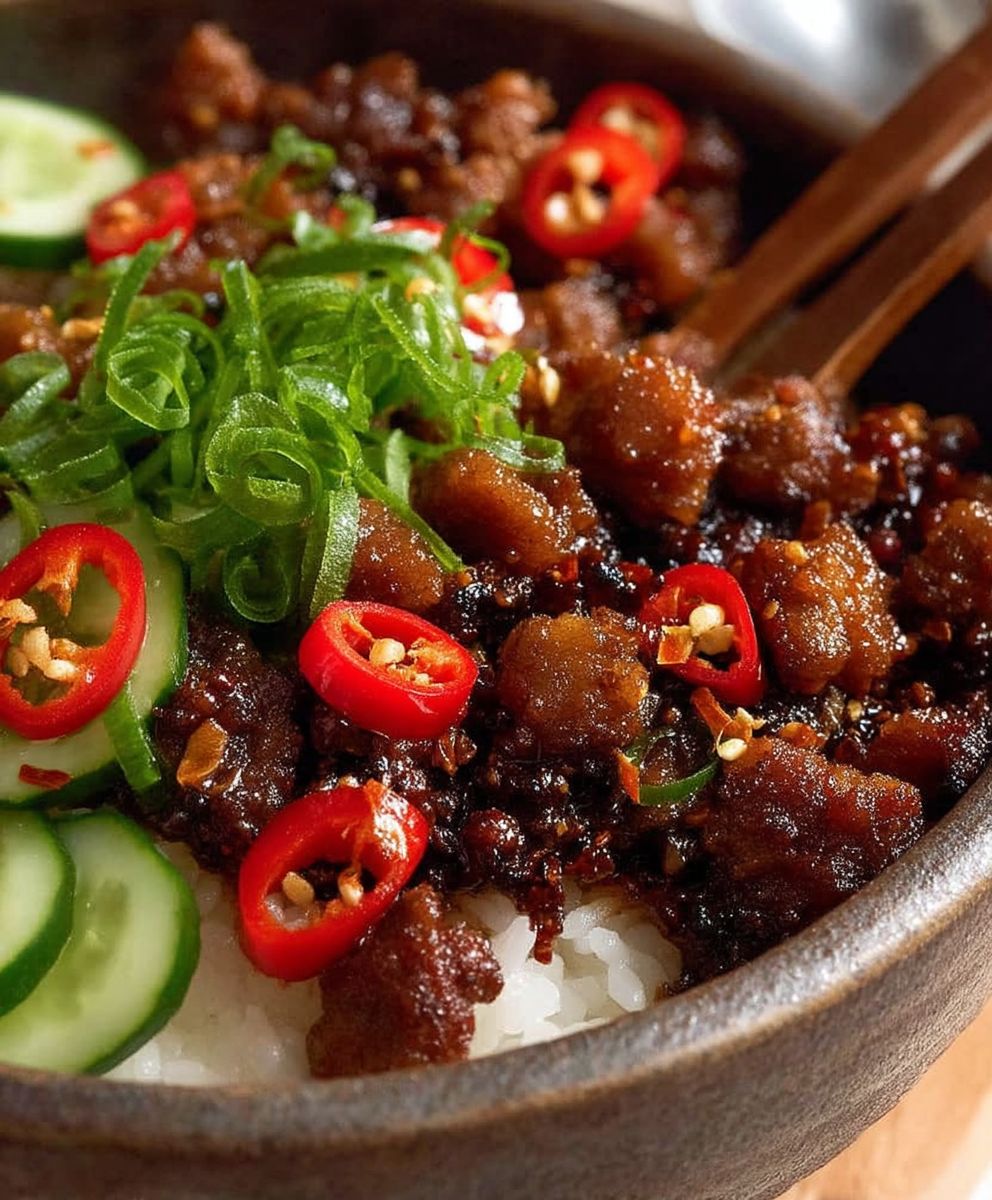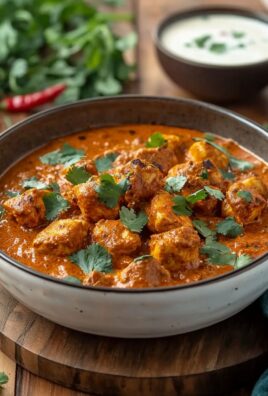Vietnamese Caramelised Pork, or Thit Kho Tau as it’s known in Vietnam, is a dish that whispers of home, family gatherings, and the comforting aroma that fills the kitchen for hours. Imagine succulent pieces of pork belly, meltingly tender, simmered in a rich, sweet, and savory caramel sauce that clings to every morsel. Are you ready to experience a culinary journey that’s both deeply satisfying and surprisingly simple?
This iconic dish holds a special place in Vietnamese cuisine, often prepared during T?t (Vietnamese Lunar New Year) and other significant celebrations. It symbolizes prosperity and good fortune, with the deep, rich color of the caramel representing wealth and abundance. Passed down through generations, each family often has their own unique twist on the recipe, making it a truly personal and cherished dish.
What makes Vietnamese Caramelised Pork so irresistible? It’s the perfect balance of sweet, salty, and savory flavors that dance on your palate. The tender pork, infused with the caramel’s depth, offers a delightful textural contrast. Beyond its incredible taste, it’s also a relatively easy dish to prepare, making it a weeknight winner that will impress your family and friends. Plus, it tastes even better the next day, as the flavors continue to meld and deepen. So, let’s embark on this delicious adventure and create a truly unforgettable meal!
Ingredients:
- 1.5 lbs pork belly, skin removed and cut into 1-inch cubes
- 2 tablespoons vegetable oil
- 1 large shallot, finely chopped
- 4 cloves garlic, minced
- 1-inch piece of ginger, peeled and minced
- 1/4 cup granulated sugar
- 1/4 cup fish sauce (nuoc mam)
- 2 tablespoons soy sauce
- 1 tablespoon dark soy sauce (optional, for richer color)
- 1 cup water
- 1 teaspoon freshly ground black pepper
- 1 red chili, thinly sliced (optional, for heat)
- 2 green onions, thinly sliced, for garnish
- Cooked rice, for serving
Preparing the Pork and Aromatics:
- First things first, let’s get our pork ready. Make sure your pork belly is cut into roughly 1-inch cubes. This size is perfect for even cooking and maximum caramelization. Pat the pork cubes dry with paper towels. This helps them brown beautifully later on.
- Now, let’s prep our aromatics. Finely chop the shallot. You want it nice and small so it melts into the sauce. Mince the garlic and ginger as well. These three ingredients are the foundation of our flavor profile.
Creating the Caramel:
- This is where the magic happens! In a large, heavy-bottomed pot or Dutch oven (I prefer a Dutch oven for even heat distribution), heat the vegetable oil over medium heat.
- Add the granulated sugar to the pot. Now, be patient! Let the sugar melt slowly and evenly. Do not stir it! Stirring can cause the sugar to crystallize. Just let it sit and melt.
- As the sugar melts, it will start to turn a light golden color. Keep a close eye on it. You want it to turn a deep amber color, but be careful not to burn it. Burnt sugar will make your dish bitter. The color should resemble a dark honey or maple syrup. This process usually takes about 5-7 minutes.
- Once the sugar has reached that beautiful amber color, immediately add the chopped shallot, minced garlic, and minced ginger. Be careful, as the caramel may splatter a bit. Stir quickly to coat the aromatics in the caramel. Cook for about 1 minute, until the aromatics are fragrant.
Braising the Pork:
- Now, it’s time to add the pork. Add the pork cubes to the pot and stir well to coat them in the caramel mixture. Make sure each piece gets a good coating.
- Add the fish sauce, soy sauce, and dark soy sauce (if using). Stir to combine. The fish sauce adds that signature umami flavor, and the soy sauces contribute saltiness and depth.
- Pour in the water. The water will help to deglaze the pot and create the braising liquid.
- Season with freshly ground black pepper. Don’t be shy with the pepper; it adds a nice warmth to the dish.
- If you like a little heat, add the thinly sliced red chili. Remember, you can always add more later, but you can’t take it away!
- Bring the mixture to a simmer. Once it’s simmering, reduce the heat to low, cover the pot, and let it braise for at least 1.5 to 2 hours, or until the pork is incredibly tender and easily falls apart when prodded with a fork. The longer it braises, the more flavorful it will become.
- During the braising process, check the pot occasionally. If the liquid is reducing too quickly, add a little more water. You want to maintain a good amount of sauce.
Reducing the Sauce and Finishing Touches:
- After the pork has braised for the specified time, remove the lid from the pot. Increase the heat to medium and let the sauce reduce and thicken. This will concentrate the flavors and create that beautiful, glossy caramel glaze.
- Stir occasionally to prevent the pork from sticking to the bottom of the pot.
- Continue to cook until the sauce has thickened to your desired consistency. It should be thick enough to coat the pork nicely. This usually takes about 15-20 minutes.
- Taste the sauce and adjust the seasoning if needed. You may want to add a little more fish sauce for saltiness or a touch of sugar for sweetness.
- Once the sauce is thick and the pork is beautifully glazed, remove the pot from the heat.
Serving:
- Serve the Vietnamese Caramelized Pork hot over cooked rice. The rice will soak up all that delicious sauce.
- Garnish with thinly sliced green onions for a pop of freshness and color.
- Enjoy! This dish is best served immediately, but it can also be stored in the refrigerator for up to 3 days. Reheat gently before serving.
Tips and Variations:
- Pork Shoulder: If you can’t find pork belly, you can use pork shoulder (also known as Boston butt). It will require a longer braising time, about 2.5 to 3 hours, to become tender.
- Coconut Water: For a slightly sweeter and more complex flavor, substitute the water with coconut water.
- Hard-Boiled Eggs: Add hard-boiled eggs to the pot during the last 30 minutes of braising. They will soak up the sauce and become incredibly flavorful.
- Tofu: For a vegetarian option, substitute the pork with firm tofu. Press the tofu to remove excess water, then pan-fry it until golden brown before adding it to the caramel sauce. Braise for a shorter time, about 30 minutes, to allow the tofu to absorb the flavors.
- Spice Level: Adjust the amount of chili to your liking. You can also add a pinch of red pepper flakes for extra heat.
- Serving Suggestions: Serve with a side of pickled vegetables, such as carrots and daikon radish, for a refreshing contrast to the richness of the pork.
Storage Instructions:
Leftover Vietnamese Caramelized Pork can be stored in an airtight container in the refrigerator for up to 3 days. To reheat, gently warm it in a saucepan over low heat, adding a splash of water if needed to prevent it from drying out. You can also reheat it in the microwave, but be careful not to overcook it.
Nutritional Information (Approximate):
Please note that the nutritional information is an estimate and may vary depending on the specific ingredients used and portion sizes.
- Calories: Approximately 450-550 per serving
- Fat: 30-40g
- Protein: 25-35g
- Carbohydrates: 20-30g
Why This Recipe Works:
This recipe is a classic for a reason! The combination of sweet, savory, and umami flavors is irresistible. The caramelization process adds a depth of flavor that is simply unmatched. The long braising time ensures that the pork is incredibly tender and flavorful. The simple ingredients and straightforward instructions make this recipe accessible to home cooks of all skill levels.
Troubleshooting:
- Sugar Burning: If the sugar starts to burn, immediately remove the pot from the heat and let it cool slightly before adding the aromatics. You may need to start over if the sugar is too burnt.
- Sauce Too Thin: If the sauce is not thickening enough, continue to cook it over medium heat until it reaches your desired consistency. You can also add a cornstarch slurry (1 tablespoon cornstarch mixed with 2 tablespoons cold water) to help thicken it.
- Pork Not Tender Enough: If the pork is not tender enough after the specified braising time, continue to braise it for longer, checking it every 30 minutes until it reaches the desired tenderness.

Conclusion:
And there you have it! This Vietnamese Caramelised Pork recipe is truly a must-try, and I’m not just saying that. The combination of savory, sweet, and slightly spicy flavors creates an explosion in your mouth that’s simply unforgettable. It’s a dish that’s both comforting and exciting, perfect for a weeknight dinner or a special occasion. The tender, melt-in-your-mouth pork, coated in that rich, glossy caramel sauce, is guaranteed to become a family favorite.
What makes this recipe so special is its simplicity. Don’t let the fancy name intimidate you; it’s surprisingly easy to make with readily available ingredients. The entire process, from prepping the ingredients to serving the finished dish, is straightforward and manageable, even for beginner cooks. Plus, the aroma that fills your kitchen as the pork caramelizes is absolutely divine! It’s an experience for all the senses.
But the best part? The versatility! While this recipe is fantastic as is, there are so many ways to customize it to your liking. For a spicier kick, add a pinch of red pepper flakes or a finely chopped chili to the marinade. If you prefer a sweeter flavor, increase the amount of sugar slightly. You can also experiment with different cuts of pork, such as pork belly for an extra decadent treat, or pork shoulder for a leaner option.
Serving suggestions are endless! I personally love serving this Vietnamese Caramelised Pork with steamed jasmine rice and a side of fresh, crunchy vegetables like cucumber and carrots. The rice soaks up all that delicious caramel sauce, while the vegetables provide a refreshing contrast to the richness of the pork. You could also serve it in lettuce wraps with fresh herbs like mint and cilantro for a lighter, more refreshing meal. Another great option is to use it as a filling for banh mi sandwiches, adding pickled vegetables and a smear of mayonnaise for an authentic Vietnamese experience.
For a complete meal, consider adding a simple stir-fried vegetable dish like bok choy or gai lan (Chinese broccoli). The bitterness of the greens complements the sweetness of the pork beautifully. A side of Vietnamese spring rolls would also be a fantastic addition, adding another layer of flavor and texture to the meal.
Don’t be afraid to get creative and experiment with different variations and serving suggestions. The beauty of this recipe is that it’s so adaptable to your personal preferences. Whether you’re a seasoned cook or a complete beginner, I’m confident that you’ll be able to create a delicious and satisfying meal with this recipe.
So, what are you waiting for? Gather your ingredients, put on some music, and get ready to embark on a culinary adventure. I promise you won’t be disappointed. This Vietnamese Caramelised Pork is a recipe that you’ll want to make again and again.
I’m so excited for you to try this recipe! Once you’ve made it, please come back and share your experience in the comments below. I’d love to hear about any variations you tried, what you served it with, and how much you enjoyed it. Your feedback is invaluable and helps me to improve my recipes and share them with others. Happy cooking!
Vietnamese Caramelised Pork: A Delicious & Easy Recipe
Tender pork belly braised in a rich, sweet, and savory caramel sauce. This Vietnamese Caramelized Pork (Thit Kho Tau) is a flavorful and comforting dish perfect served over rice.
Ingredients
- 1.5 lbs pork belly, skin removed and cut into 1-inch cubes
- 2 tablespoons vegetable oil
- 1 large shallot, finely chopped
- 4 cloves garlic, minced
- 1-inch piece of ginger, peeled and minced
- 1/4 cup granulated sugar
- 1/4 cup fish sauce (nuoc mam)
- 2 tablespoons soy sauce
- 1 tablespoon dark soy sauce (optional, for richer color)
- 1 cup water
- 1 teaspoon freshly ground black pepper
- 1 red chili, thinly sliced (optional, for heat)
- 2 green onions, thinly sliced, for garnish
- Cooked rice, for serving
Instructions
- Prepare Pork and Aromatics: Pat the pork belly cubes dry with paper towels. Finely chop the shallot, mince the garlic, and mince the ginger.
- Create the Caramel: In a large, heavy-bottomed pot or Dutch oven, heat the vegetable oil over medium heat. Add the granulated sugar and let it melt slowly and evenly *without stirring*.
- As the sugar melts, it will turn a light golden color. Keep a close eye on it. You want it to turn a deep amber color, but be careful not to burn it. Burnt sugar will make your dish bitter. The color should resemble a dark honey or maple syrup. This process usually takes about 5-7 minutes.
- Once the sugar has reached that beautiful amber color, immediately add the chopped shallot, minced garlic, and minced ginger. Be careful, as the caramel may splatter a bit. Stir quickly to coat the aromatics in the caramel. Cook for about 1 minute, until the aromatics are fragrant.
- Braise the Pork: Add the pork cubes to the pot and stir well to coat them in the caramel mixture. Add the fish sauce, soy sauce, and dark soy sauce (if using). Stir to combine.
- Pour in the water. Season with freshly ground black pepper and add the sliced red chili (if using).
- Bring the mixture to a simmer. Reduce the heat to low, cover the pot, and let it braise for at least 1.5 to 2 hours, or until the pork is incredibly tender. Check occasionally and add more water if the liquid reduces too quickly.
- Reduce the Sauce: After braising, remove the lid and increase the heat to medium. Let the sauce reduce and thicken, stirring occasionally, for about 15-20 minutes, or until it reaches your desired consistency.
- Taste the sauce and adjust the seasoning if needed.
- Serve: Serve hot over cooked rice, garnished with thinly sliced green onions.
Notes
- Pork Shoulder: If you can’t find pork belly, you can use pork shoulder (also known as Boston butt). It will require a longer braising time, about 2.5 to 3 hours, to become tender.
- Coconut Water: For a slightly sweeter and more complex flavor, substitute the water with coconut water.
- Hard-Boiled Eggs: Add hard-boiled eggs to the pot during the last 30 minutes of braising. They will soak up the sauce and become incredibly flavorful.
- Tofu: For a vegetarian option, substitute the pork with firm tofu. Press the tofu to remove excess water, then pan-fry it until golden brown before adding it to the caramel sauce. Braise for a shorter time, about 30 minutes, to allow the tofu to absorb the flavors.
- Spice Level: Adjust the amount of chili to your liking. You can also add a pinch of red pepper flakes for extra heat.
- Serving Suggestions: Serve with a side of pickled vegetables, such as carrots and daikon radish, for a refreshing contrast to the richness of the pork.
- Sugar Burning: If the sugar starts to burn, immediately remove the pot from the heat and let it cool slightly before adding the aromatics. You may need to start over if the sugar is too burnt.
- Sauce Too Thin: If the sauce is not thickening enough, continue to cook it over medium heat until it reaches your desired consistency. You can also add a cornstarch slurry (1 tablespoon cornstarch mixed with 2 tablespoons cold water) to help thicken it.
- Pork Not Tender Enough: If the pork is not tender enough after the specified braising time, continue to braise it for longer, checking it every 30 minutes until it reaches the desired tenderness.




Leave a Comment